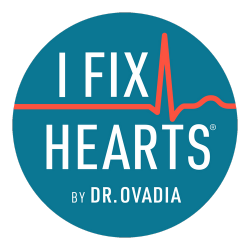I’ve made no secret of the fact that I used to be fat. Officially, I was obese, carrying over 100 pounds in excess weight.
My parents were also obese, both eventually opting for gastric bypass surgery.
A lot of people would have told me I was genetically destined to be obese. This was a concept I had been taught in school and I believed it.
The hardest part for my family was that we didn’t become obese from guzzling sodas and eating Big Macs every day.
We followed the official guidelines for healthy eating!
I played sports. We ate margarine instead of butter. We chose low-fat, diet, and sugar-free options whenever possible.
The USDA, AHA, and Food Pyramid told us this was how to eat healthily, to be healthy.
Yet here was the Ovadia family, unhappily buying larger clothes to fit our ever-expanding waistlines.
Fortunately I found better advice, but not until I was 40 years old.
If you’re struggling to manage your weight despite following official guidelines, you may be facing the same predicament I did.
I want you to know that no matter how impossible it feels, you can lose weight and keep it off. You just have to unlearn the shoddy science of the food pyramid first.
Let’s take a look at the facts.
A look at the original food pyramid

This is the original food pyramid. If you’re unfamiliar with it, the items at the base of the pyramid should make up the majority of your daily intake. You eat less of the items moving up the pyramid, with the tip representing the smallest amount to consume.
As you can see, the official recommendation was to make carbohydrates the base of your daily intake. Specifically bread, pasta, and cereal get highlighted, with a suggested intake of 6-11 servings every day.
You’re then supposed to eat a lot of fruits and vegetables.
The foods you’re meant to eat the least amount of are proteins and fats. And it’s fascinating that fats are put in the same category as sweets!
Let’s dive into this in more detail.
- First, the carbohydrates. Aside from the impact a diet heavy in carbohydrates can have on insulin sensitivity, these foods are simply not filling. We all know that feeling of eating a huge bowl of pasta and feeling hungry again a short while later, or how easy it is to eat a lot of bread. It’s therefore easy to quickly eat more than our body needs, resulting in weight gain. Not only that, but as we get used to eating higher quantities, we desire even more. It’s a vicious cycle and is incredibly hard to break.
- Next, we move up to fruits and vegetables. These can be more filling and contain good nutrients, but they’re not very substantial. Making them a foundational component of your diet won’t necessarily help in your fight with the flab.
- Now we get to the bigger problem: the official guidelines demonize protein and fat. Not only do these foods contain lots of minerals and nutrients that our body needs, but they’re also essential for losing fat! Protein and fat keep us feeling full for longer, which stops us from overeating and can address insulin sensitivity. While it’s not difficult to eat bowl after bowl of cereal or pasta, there are few people who could eat steak after steak and feel hungry!
It’s also concerning that “oils” are presented as though there’s no difference between the many types. There’s no mention of choosing healthy oils over unhealthy oils. In reality, humans should only be consuming a few types of oil, such as extra virgin olive oil or coconut and animal derived fats, such as butter, tallow, and lard. We should avoid seed oils and vegetable oils – yet the cheap price means these are used extensively, from restaurants to processed foods. If you look at the ingredients of any food item in your fridge or pantry, from mayonnaise to granola, you’re likely to see an unhealthy oil listed.
Even if you do buy extra virgin olive oil, regulatory failings mean that we can’t even be sure we’re buying the real stuff. As much as 80% of the olive oil on our shelves is fake. Sadly, the prevalence of unhealthy foods around us makes it difficult and confusing to improve our health.
That’s why I’m so committed to helping people now, so more people have a chance to become healthy, fit, and energetic.
The new ‘food pyramid’ you need to follow
I know what it’s like to follow so-called ‘scientific’ nutrition guidelines and getting nowhere. It’s like following the rules at school but getting punished anyway.
That’s why I started following a new food pyramid to restore my metabolic health.
I began:
- Eating primarily animal protein as part of a carnivore diet.
- Switching to fats instead of carbohydrates for fuel.
- Working to cut sugar from my diet.
As of today, I’ve lost nearly 100 pounds and kept it off. I’m not thinking about food every hour of the day or following strict ‘diet culture’ guidelines in an attempt to manage my weight.
I’m the healthiest I’ve ever been — and I want to help you get there, too.
If you want to cut through all the confusion and know exactly what to eat to become the healthiest you’ve ever been, and to Stay Off My Operating Table®, then take my free metabolic quiz and let’s get you on the right path.
